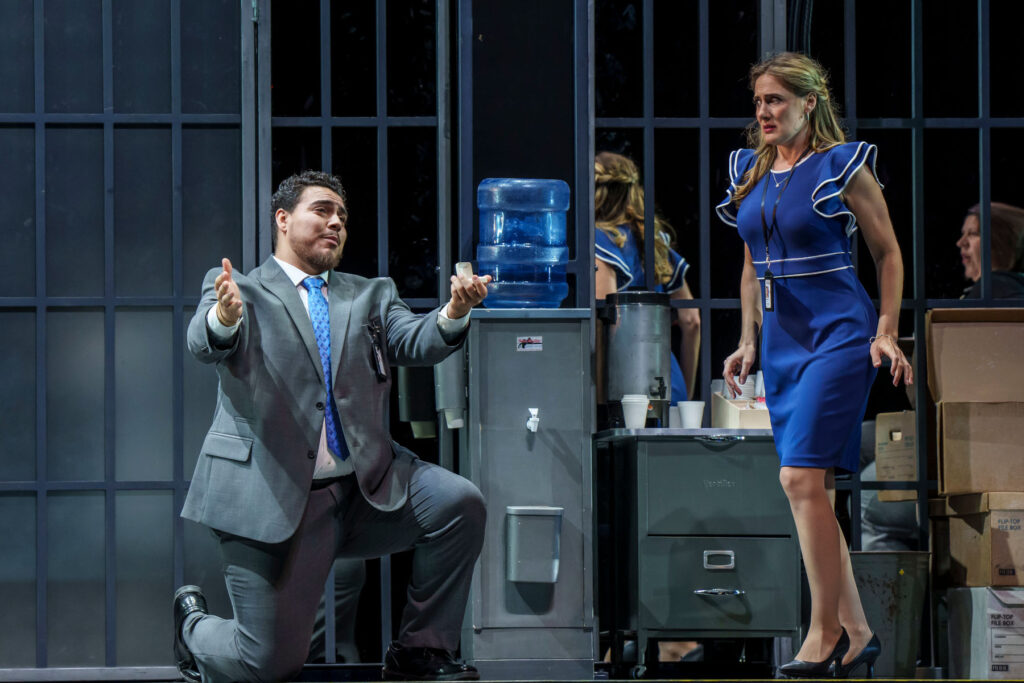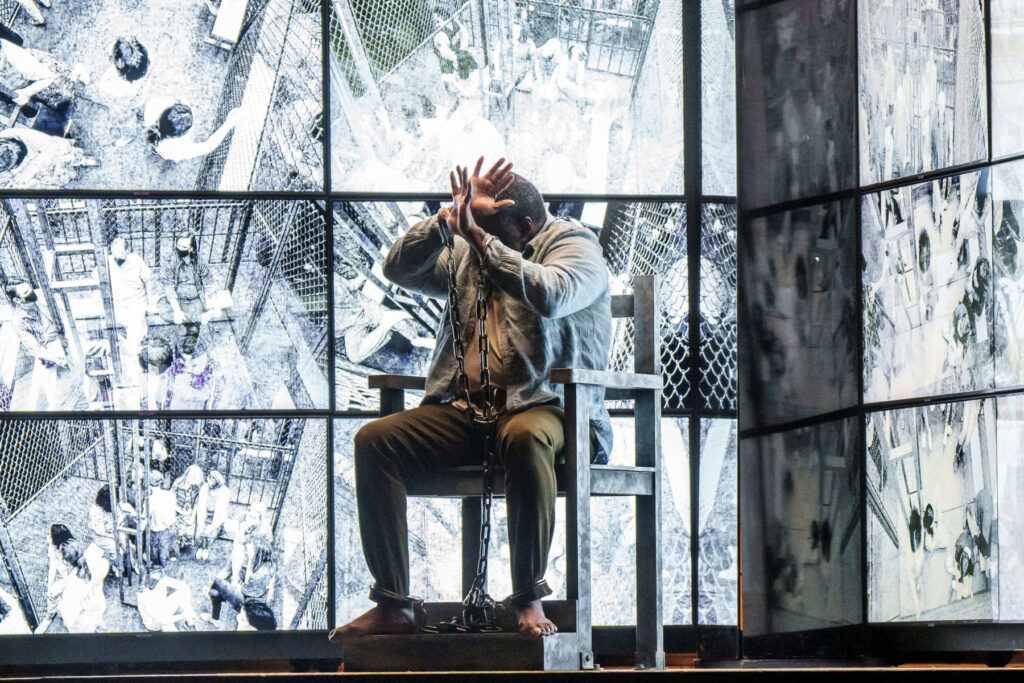For its second opera in the 2024-25 season Lyric Opera of Chicago has presented Ludwig van Beethoven’s Fidelio. The role of Leonore, who has assumed the male identity Fidelio while searching for her captured husband, is sung by Elza van den Heever. Her imprisoned husband Florestan is Russell Thomas. Dimity Ivashchenko sings the principal jailer Rocco., his superior, the governor Don Pizarro being here portrayed by Brian Mulligan. Rocco’s daughter Marzelline is sung by Sydney Mancasola, and her frustrated suitor Jaquino is Daniel Espinal. The minister Don Fernando, whose arrival ultimately solves the chief conflict, is Alfred Walker. The first and second prisoners are performed by Travon D. Walker and Christopher Humbert, Jr. The director of this production, which originated at the San Frncisco Opera, is Matthew Ozawa. The set, costume, and lighting designers are Alexander V. Nichols, Jessica John, and Yuki Nakase Link. The Lyric Opera Orchestra is conducted by Enrique Mazzola and the Lyric Opera Chorus is prepared by Michael Black. Making debuts at Lyric Opera of Chicago are Mmes. Mancasola and Link, as well as Messrs. Espinal and Nichols.

The bi-level rendering of a prison and associated clerical space allows sufficient opportunity for movement of principal characters and for the later emergence and procession of prisoners. In the first act the use of lighting projected from above and a staircase located at stage left direct attention to the participants in their varied positions, In the second act a modification of this set and lighting suggests the deepest dungeon of the prison.
The duet at the opening of the first scene between Marzelline and Jaquino is performed in the attire and accompanied by the gestures suggesting an office. Mr. Espinal pleads his suit and expresses Jaquino’s emotional interest with urgency, while Ms. Mancasola’s character tends to the prison’s clerical work, a clear departure from Marzelline’s accustomed activity of ironing, Mancasola’s reactions are appropriately disinterested, given her newly kindled affections for Fidelio. The duet proceeds, with each singer gaining intensity of expression, as interruptions at the gate prevent their communication. Only Rocco’s offstage calls for Jaquino’s attentions bring the tense duet to a close.When left alone, Marzelline muses on her growing feelings for the newcomer Fidelio and her hopes of marriage. In her aria, “O wär’ ich schon mit dir vereint” [“Oh if only I were already wed to you”], Mancasola gives a sympathetic performance of her character’s aspirations. Sensitivity to textual line is matched by expressive top notes. Her phrasing lingers ironically on “dich nennen” [“to call you (husband”)], while the close of the first refrain is taken with rubato on “glücklich warden” [“become happy”]. Mancasola’s voice glides lovingly across the accelerated tempos of the second stanza and concludes the final line with touching decoration, again on “glücklich werden.”

In the following scene the entrances of Rocco and Leonore, in the guise of Fidelio, supplements the narrative and emotional framework of the opera’s plot. Mr. Ivashchenko’s Rocco is, at once, paternal and complicit. As Leonore / Fidelio Ms. van den Heever projects a believable male image, when she struggles to complete arduous tasks for the jail. Both singers contribute admirably to the quartet beginning with Marzelline’s “Mir ist so wunderbar.” Each of the singers in this well-balanced performance expresses hope, apprehension, or frustration for the possibility or denial of emotional reward. As a pathetic twist on Marzelline’s “wunderbar” from the start, Jaquino uses the word in his lines while Espinal plucks the petals from a flower of love, ultimately casting the posey to the ground in frustration.
Yet love alone does not suffice, as Rocco reminds in his aria “Hat man nicht das Gold beineben” [“If a supply of gold is not available as well”]. Here Ivashchenko shows his mastery of this repertoire. His rich, flexible voice expresses with legato both descriptive lines and the skilled decoration applied for emphasis. High pitches are evenly pure and contrast nicely with a final, deeply intoned “das Gold.” The following discussion of a prisoner, to whom Leonore requests access at Rocco’s side, leads into the trio for Leonore, Rocco, and Marzelline, “Ich habe Mut” [“Courage I have”]. Rocco agrees with Fidelio, he wishes the youth to share the responsibilities of the jail and to marry his daughter. Almost at once Don Pizarro enters and begins to shuffle through accumulated correspondence, where he reads that the minister plans a visit to the prison. The political prisoner Florestan is rumored to be alive and kept, at Pizarro’s direction, in captivity. Resolved to commit a “kühne Tat” [“bold deed”], Mr. Mulligan’s Pizarro performs his aria of vengeance, “Welch’ ein Augenblick!” [“What a moment!”] with gusto and appropriately held pitch on “Triumph!” In the following scene and duet Pizarro conspires with Rocco to have Florestan killed and orders him to have the body removed before the visit of the minister.

This scene is ideally staged on the bi-level set, Leonore standing below and able to overhear with horror. The reaction of van den Heever in her performance of “Abscheulicher!” [“Wretched man!”] is a wrenchingly credible expression of accusation and fidelity. Generous tempos in the first half of the aria allow van den Heever to vary color effectively, while rising pitches at the close of this first part of the aria could be more distinctly enunciated and connected. In the second, rapid part of the aria rage is surely here communicated with an extended top pitch saved for the close.
The stage accommodates a procession of prisoners as they emerge and wander under control in the courtyard. Such empathetic treatment of the captives is urged by Leonore in the hope of seeing her husband. As the act closes in confusion and sadness, Leonore realizes, as the gates are forcibly closed, that her husband’s fate remains a mystery.
The representation of imprisonment and suffering at the start of the brief, second act depends squarely on the innovative staging of this production. In a massive cage of transparent metalwork, approximating the dungeon of isolation, Florestan remains chained. The cage is studded with lights reminding of a constant and never-ending torture. Mr. Thomas’s opening crescendo on his appeal to the divinity, “Gott,” initiates his call for understanding and determination that has kept Florestan alive until now. His dramatic expression of the aria defines the character. The strained top notes at the close of the piece seem to suggest the prisoner’s fatigue. The arrival in the depths of Rocco and Leonore, each with varied purpose, breaks a spell of confinement. With difficulty the two work on releasing Florestan from his fetters. Pizarro’s expected approach and plan to end the life of Florestan leads here to an appropriately intense confrontation. In a rapid sequence, van den Heever protects her husband with outstretched arms while immediately identifying herself. The surprise of the male characters simply prompts Mulligan’s rage and his resolve to kill both husband and wife, whom Pizarro names with great sarcasm, “Madam.” The announcement of Don Fernando’s timely arrival, the arrest of Pizarro, and joyous shouts between van den Heever and Thomas conclude the penultimate scene.
Mr.Walker’s dignified and benevolent portrayal of Don Fernando sets the tone for the final scene of manifold reconciliation. The townspeople and freed prisoners echo the happiness of the reunited couple in skillfully blocked movements across the transformed stage.
Salvatore Calomino
Top image: The Company of Fidelio. Photo © Lyric Opera of Chicago. All other photos © Todd Rosenberg Photography.